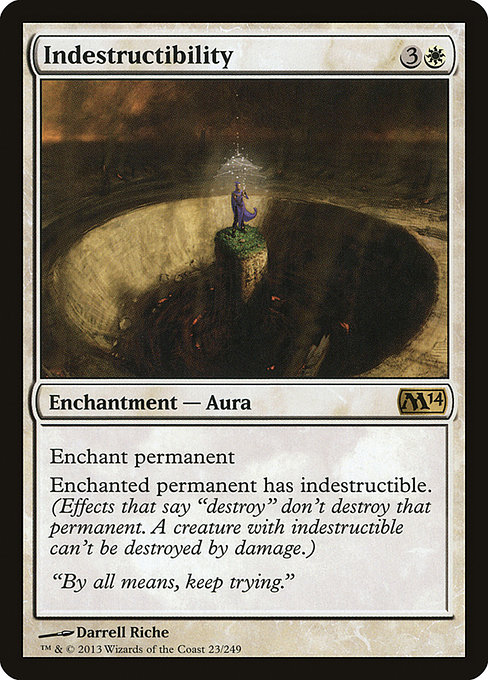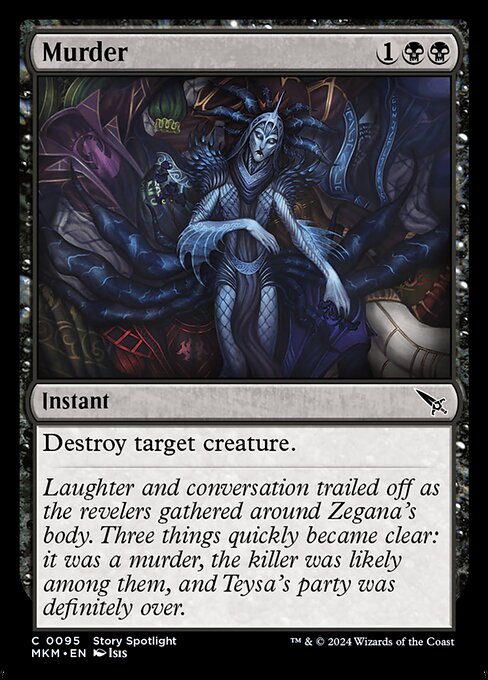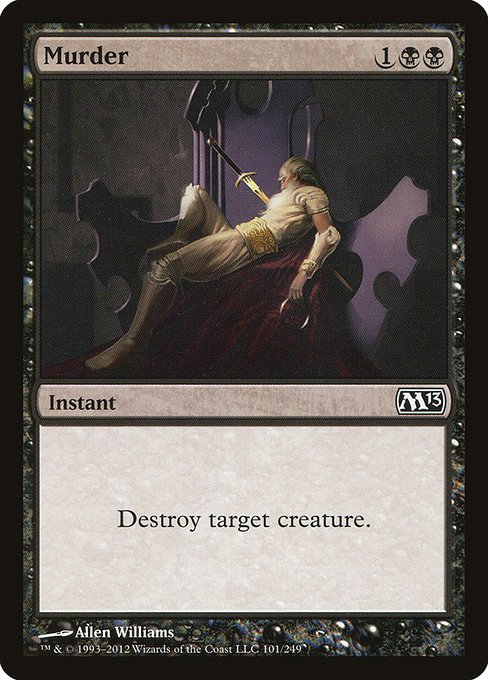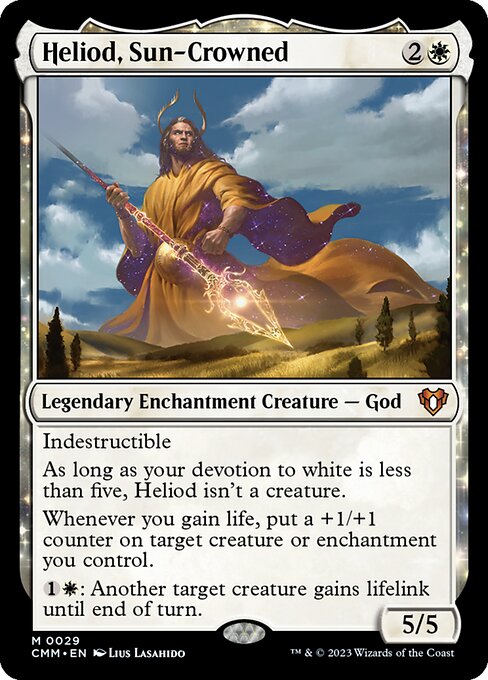If you’re a custom Magic card designer, you probably know what I’m talking about. You’re designing a card, you really like it, but it’s not enough. So you add a thing, then another, then another, and suddenly your card has 12 lines of text. How could that happen?
Hiya everyone, LudosGD here, and I struggle a lot with simplicity in Magic card design, even though I’m fascinated by it. Many of my favorite cards are simple designs: Evolving Wilds , Indestructibility
, Indestructibility , Plot Armor
, Plot Armor . So, I decided to write this article, in an attempt to offer you some tips and tricks that might help you (and myself) design simpler cards. Let’s start!
. So, I decided to write this article, in an attempt to offer you some tips and tricks that might help you (and myself) design simpler cards. Let’s start!
What is “Simple”?
This is a question that deserves an article of its own, so we’ll keep things simple (hehe) and say we’ll focus mostly on line count. We’ll try to think about rules text and how to get it to its shorter version, both in top-down and bottom-up design, and we’ll briefly touch on contextualization and focus too.
Simplicity in Top-Down Design
With “top-down design” we identify card designs that take a flavor concept and try to capture it in mechanical execution. How do we think about simplicity in top-down design? Let’s focus on an example.
Let’s say you’re designing a card for your murder mystery set. You decide that the name “Murder” for a card is very resonant so you set out to design it. You immediately decide that it’s a common black removal spell. Thinking about what “murder” means, you decide it doesn’t affect neither artifact creatures, nor Spirits, because they are, well, not “alive”, technically. Murders get investigated, so you decide that the controller of the removed creature should probably investigate, because that’s what you do with murders in murder mystery sets, right? So you now have this design:
Murder {1}{B}
Instant
Destroy target nonartifact, non-Spirit creature. Its controller investigates. (They create a colorless Clue artifact token with “{2}, Sacrifice this artifact: Draw a card.”)
Except, as you probably know, Murder already exists, as one of the simplest and most resonant cards ever.
already exists, as one of the simplest and most resonant cards ever.

Which of the two cards do you prefer? I bet the second one. But why? Like yeah it’s simpler, but somehow, it feels more flavorful than the first? How is that possible? The first is more accurate!
The problem lies in the fact that the first goes in too deep with its concept, trying to capture it in its entirety. This is impossible. You’ve probably thought of other problems with the first design: Zombies and Vampires should be immune too, since they’re undead. What about Planeswalkers? Should they be hit by Murder too?
It is mostly impossible to capture a concept in its entirety because representing it in a card is already a simplification. So what should we do? As M13’s Murder card teaches us, focus on the core of your concept. “Murder should be a removal spell for creatures” is enough, and already creates the connection between concept and mechanical execution.
What is the “core” concept? How do you recognize it? I think it’s mostly a gut feeling thing. The general idea I apply is that if you find yourself thinking about different small things that you should tweak to make your design “make more sense”, you’re probably going in too deep.
Of course this isn’t a hard rule (I like to think that in game design hard rules do not exists, only guidelines do), as simplicity is only one of many metrics applicable in card design, but it’s a good thought exercise.
Simplicity in Bottom-Up Design
“Bottom-up” design is the opposite of top-down, focusing on a mechanical idea first and then building flavor around it. How do we think about simplification in this process?
Context is key here. Let’s say you have an environment which has an Aura matters theme you want to support. Think about the simplest ways to do this. In this case, double strike is a nice mechanic to use, and you realize that many premier sets make use of an uncommon 1/1 double striker that costs {1}{W}, so you set out to design the uncommon double striker. You start like this:
Funky Double Striker {1}{W}
Creature — Human
Double strike
1/1
Now that you have a basic effect, you can either run it as-is or, if you’re feeling funkier, you can try to tweak it. Let’s try to tweak it, but in the simplest way possible, building around the context. Auras is the archetype we’re trying to support. If the environment is removal-heavy, support for Auras might like resilient bodies. Ward might be the right tool!
Funky Double Striker (drum bass remix) {1}{W}
Creature — Human
Double strike, ward {1}
1/1
And there you are! Three words, one symbol, and you have a never-before seen design (at the time of writing, the only double striker with ward is Bronze Guardian which has a severely different role from our Funky Double Striker.)
which has a severely different role from our Funky Double Striker.)
Let’s look at another example. This time we are theorycrafting a rare for a slow blue-black archetype focused on artifacts. After thinking about it for a bit, we end up with something like this:
Spirit of the Trinkets {4}{U}{B}
Creature — Spirit
Flying
Whenever an artifact enters the battlefield under your control, look at the three cards of your library. Put one of those cards into your hand and the rest into your graveyard.
{2}, {T}, Discard a card: Target opponent mills X cards, where X is the number of artifact cards into your graveyard. If an artifact card was discarded this way, you gain X life. (To mill X cards, a player puts the top X cards of their library into their graveyard.)
1/2
This is an interesting design, for sure! We have a wincon for a slow blue-black artifact deck that looks to mill out the opponent while providing card advantage and lifegain to stay alive. Little problem: it’s a bit complex, not only in the “number of lines of rules text” sense but also in the gameplay sense: it’s easy to trigger multiple times its triggered ability, especially in environments with tokens such as Clues or Treasures, and this ability requires multiple decision making points. The gameplay it generates will be most likely slow and mentally taxing, which is fine in some cases, but this time we’d prefer to make something simpler. How do we do this?
First of all, let’s think about its role in the environment. We want a wincon for a slow blue-black artifact archetype that most likely wants to win in an axis different than combat (some players love to do that and they’ll probably be naturally drawn by an artifact archetype). Milling is a good mechanic to use here. We then want to reduce the slow and difficult gameplay, so the trigger will have to change somehow. The activated is superfluous; we can accomplish our goals without it. Here’s the result:
Spirit of the Trinkets (acoustic cover) {3}{U}{B}
Creature — Spirit
Flying, lifelink
At the beginning of your end step, target opponent mills X cards, where X is the number of artifacts you control plus the number of artifact cards in your graveyard. (To mill X cards, a player puts the top X cards of their library into their graveyard.)
2/5
We went all-in on the milling ability, making it as dangerous (and as exciting!) as possible, counting both artifacts on the battlefield and in the graveyard (the previous version wanted lots of artifacts in both zones too). Triggering at the end step simplifies play patterns a ton, and makes our ghastly friend scary as soon as it enters the battlefield (the previous version probably wanted to wait until our next turn to do stuff). What about letting the player stay alive? The body takes care of this, going from a measly 1/2 flier to a big 2/5 flier with lifelink, making it excellent for blocking aggressive decks and good at attacking passive decks, to at least gain some life (we don’t want to have too much power on this one — we decided that the wincon was not combat-related!) The one thing this design doesn’t do is card advantage, but it isn’t really that necessary. An archetype like this one has probably many other card slots for card advantage.
These are just examples, obviously. Building a set and balancing themes is much more complicated and again, simplicity is only one of many metrics. But you really don’t need much to make compelling game pieces.
Contextualize in your environment, not in all of Magic
Let’s say you want to make a card named The Godslayer. It’s a legendary creature card from Kylem (the plane from Battlebond with a big arena for spectacular fights), that represents a character that loves to defeat famous warriors. So you set out and make the card.
The Godslayer {4}{B}{B}
Legendary Creature — Human Warrior
When {cardname} enters the battlefield, you may destroy target legendary creature.
Whenever a creature an opponent controls dies, put a +1/+1 counter on {cardname}.
5/5
A thing you’d be probably tempted to do is letting it destroy Gods, which are notoriously indestructible (Heliod, Sun-Crowned ), even though Kylem doesn’t have Gods. A “Godslayer” who doesn’t slay Gods? What?
), even though Kylem doesn’t have Gods. A “Godslayer” who doesn’t slay Gods? What?
But then again, simplicity enters the fray, this time joined by contextualization. If you try something like “exile target legendary creature”, then the flavor gets a bit off, and then you don’t have synergy with the second ability. You might want to let it hit Planeswalkers too, but then again that is a contextualization thing, both about the narrative (can the character defeat Planeswalkers too?) and the environment (does the set feature Planeswalkers? If they do, should this slot be used as an additional answer to their presence in the environment?) I know this is not just an example about simplicity, but all metrics are interconnected, in one way or another. A good way to think about simplicity though is limiting yourself to the rules of your environment, and not to all of Magic. Otherwise, your Godslayer would look like this:
The Godslayer {5}{B}{B}
Legendary Creature — Human Warrior
When {cardname} enters the battlefield, you may exile target legendary creature or planeswalker.
Whenever a creature or planeswalker an opponent controls dies or is exiled, put a +1/+1 counter on {cardname}.
5/5
You would not only lose the connection with the core of your concept, trying to capture too much, but you’d lose connection with the context of your set too, both flavor-wise and mechanics-wise.
Focus your design
Let’s make one last example. This time, we’ll pretend we are making a Bant (Green-White-Blue) commander that cares about morph.
Anedak, the Morphing {2}{G}{W}{U}
Legendary Creature — Djinn Wizard
Whenever {cardname} or another creature you control is turned face up, put a +1/+1 counter on that creature, then draw a card and you gain 1 life.
Face-down creatures you control have "{T}: Add one mana of any color."
{4}{G}{W}{U}: Destroy all other face-up creatures.
Morph {2}{G}{W}{U}
4/4
You probably noticed that this card is very complicated. It has four abilities, one of which is a trigger that does three things, one that complicates counting mana, one that adds an on-board trick and then one that is simply morph. There are several metrics by which in my opinion, this card has problems, but the biggest one is that it’s very unfocused. It tries to do way too many things for its archetype, in the hope to support it. Focusing your design is a good way to achieve simplicity.
Let’s try to focus on one mechanical hook. Which ability do we like more? The turning-face-up trigger? The mana-making static? Or the activated wrath? For this example, we’ll choose the mana-making one, which encourages you to create tons of morphs and to cast gigantic spells (or to turn face up lots of creatures!) The commander wants us to create tons of morphs, so let’s play into that, making use of the manifest mechanic, which puts cards directly onto the battlefield as morphs. Here’s a stab at a simplified, focused design:
Anedak, the Morphing {2}{G}{W}{U}
Legendary Creature — Djinn Wizard
Whenever {cardname} or another creature you control is turned face up, manifest the top card of your library.
Face-down creatures you control have "{T}: Add one mana of any color."
Morph {2}{G}{W}{U}
4/4
Thinking about simplicity and focus when designing cards helps you to think about how those cards play and their role in their decks.
Thank you so much for reading! I hope these little tips can help you as much as they helped me. Enjoy, stay safe and have a wonderful day!
